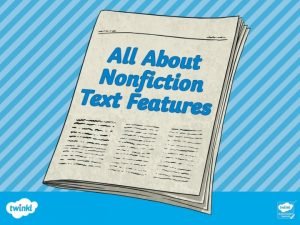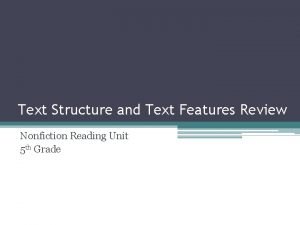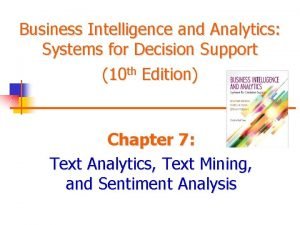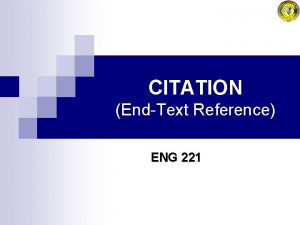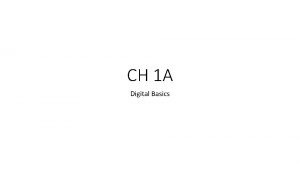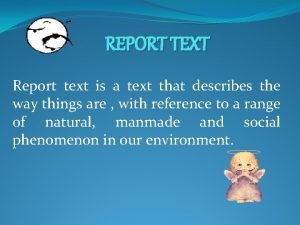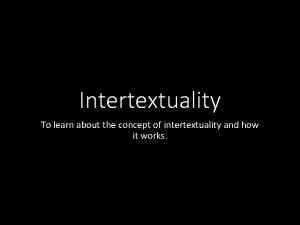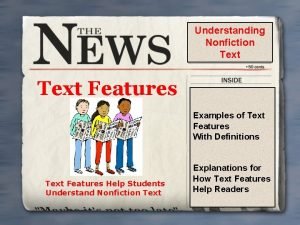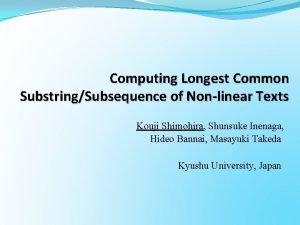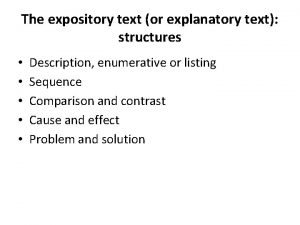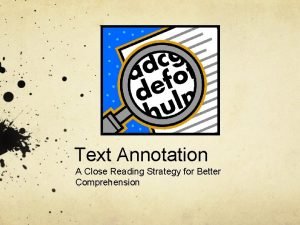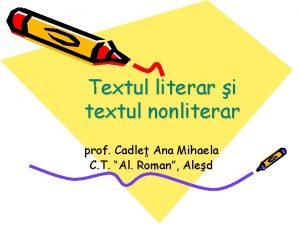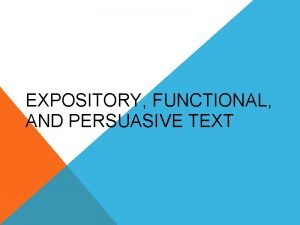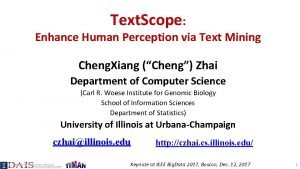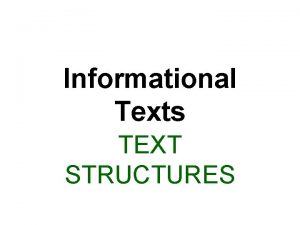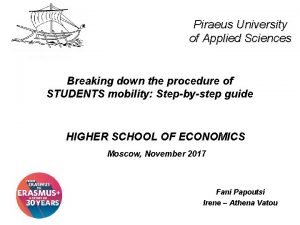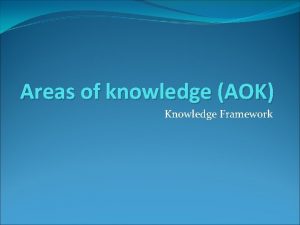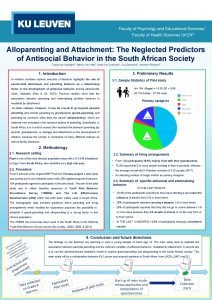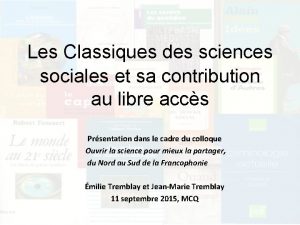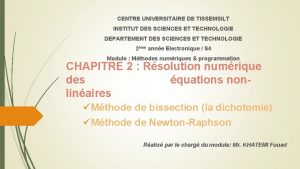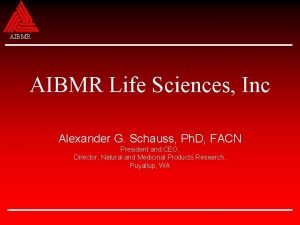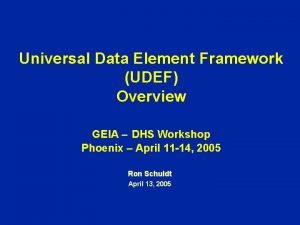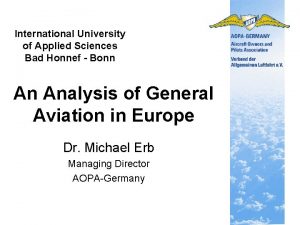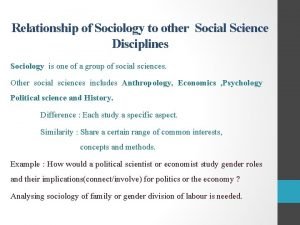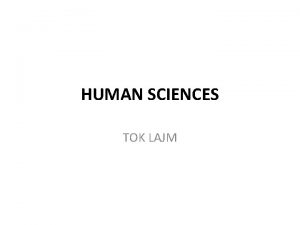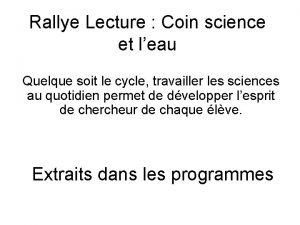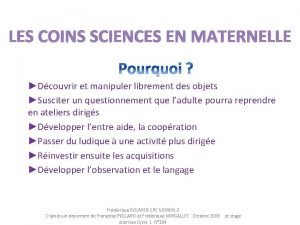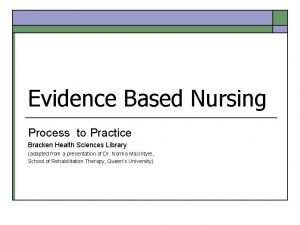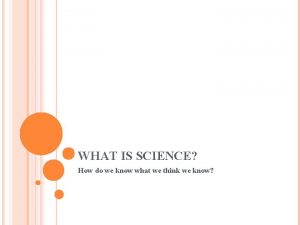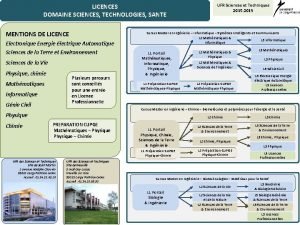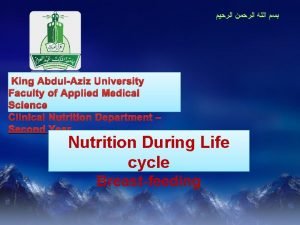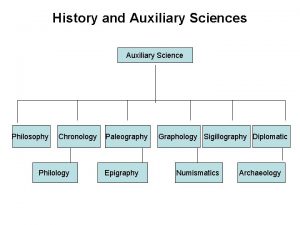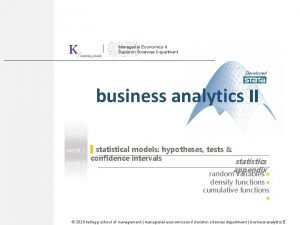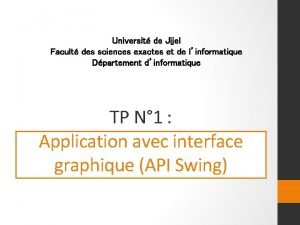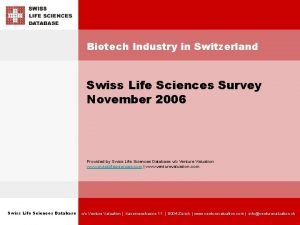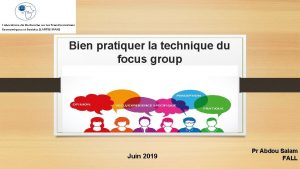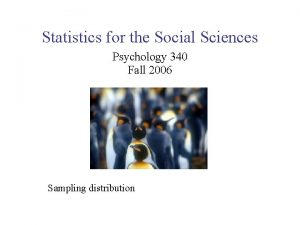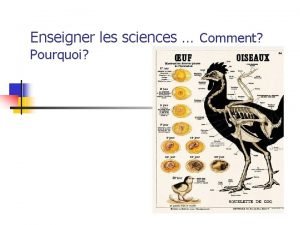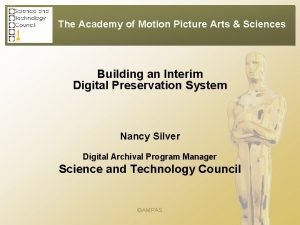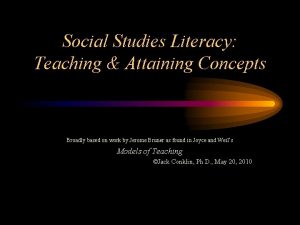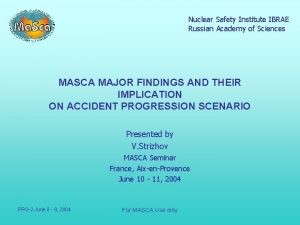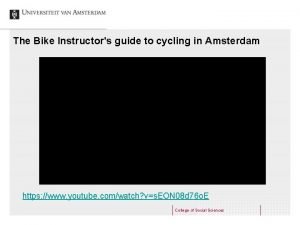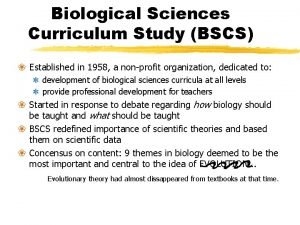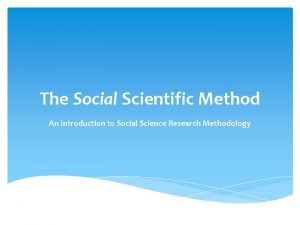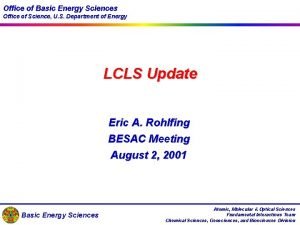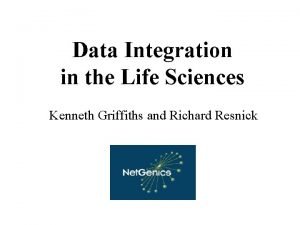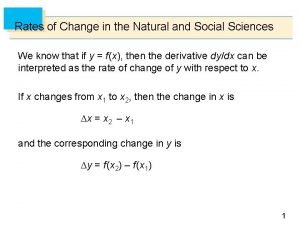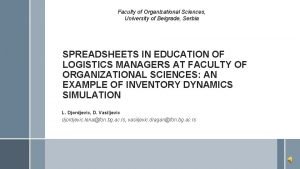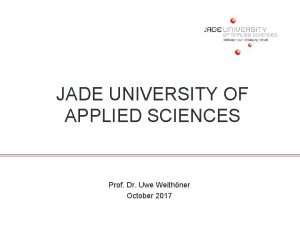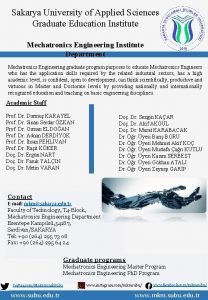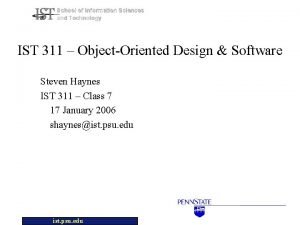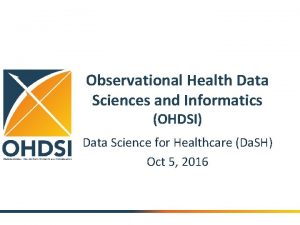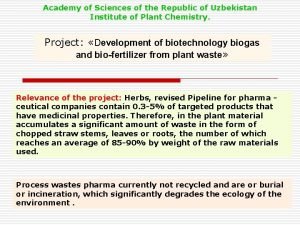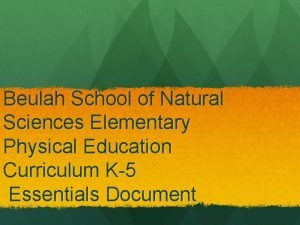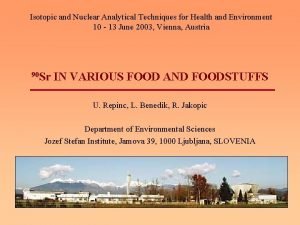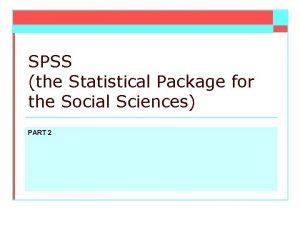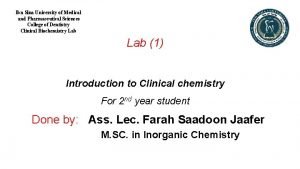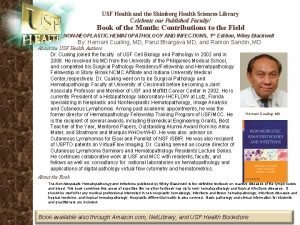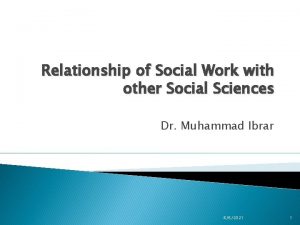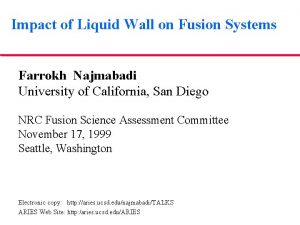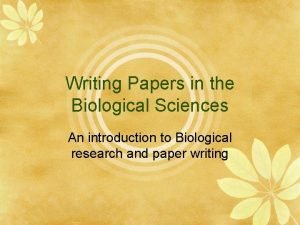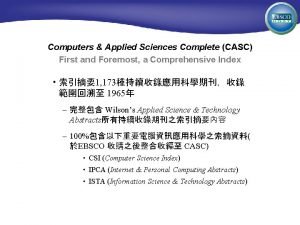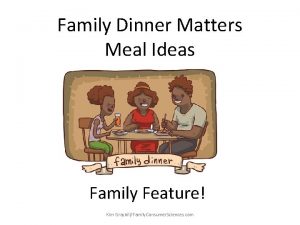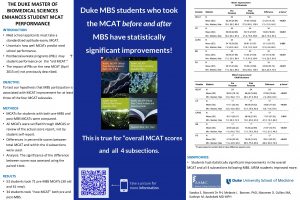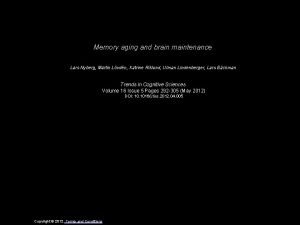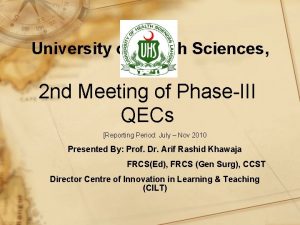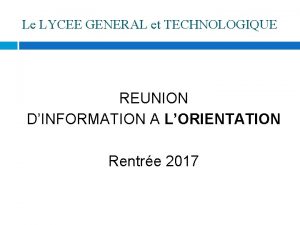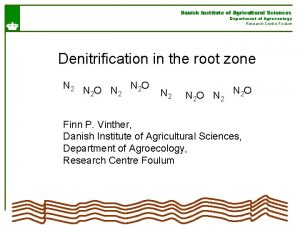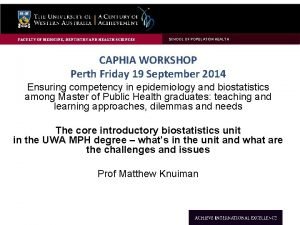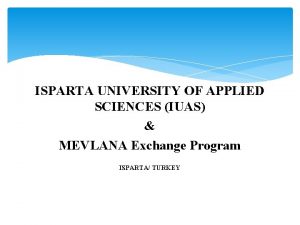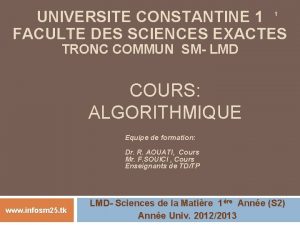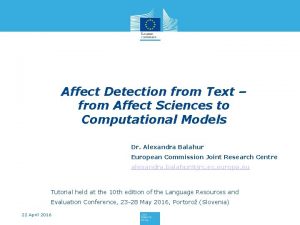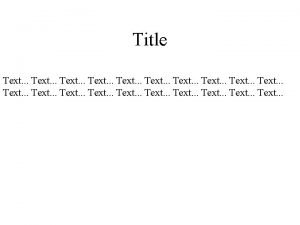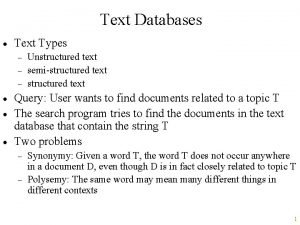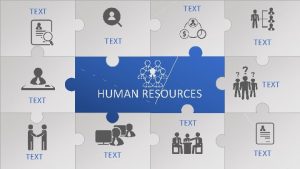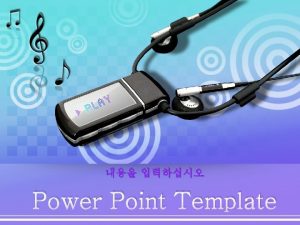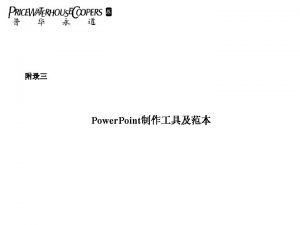Affect Detection from Text from Affect Sciences to





































































































































- Slides: 133

Affect Detection from Text – from Affect Sciences to Computational Models Dr. Alexandra Balahur European Commission Joint Research Centre alexandra. balahur@jrc. europa. eu Tutorial held at the 10 th edition of the Language Resources and Evaluation Conference, 23 -28 May 2016, Portorož (Slovenia) 22 April 2016


Affect Ø Ø Ø Ø Mythology Religions Spiritual practices Placebo effect “New Age” theories Feminism/femininity “Positive Psychology”







Turing Test & AI Ø 1950 s – Alan Turing -> 1956 - Birth of AI Ø 1637 – René Descartes § Machines that can “utter words”, “reply” Ø 1937 – Alfred Ayer § “conscious” vs. “unconscious”

Turing Test & AI Knowle dge about

Joseph Weizenbaum – 1954, MIT

Overview Ø Emotion and other “related” concepts Ø Emotion and cognition § IQ and emotional “intelligence” Ø Affect theories in Psychology § main theories on emotion, main models of emotion Ø Affect theories in Cognitive Science Ø Theories on affect in Neurosciences Ø Affective Computing and AI § Emotion detection methods § Applications – virtual worlds, Robotics, … Ø Affect detection and classification in NLP § Subjectivity analysis § Sentiment analysis § Emotion detection § Open competitions and state of the art results § Applications

From Cade Mc. Call & Tania Singer - “The animal and human neuroendocrinology of social cognition, motivation and behavior” - Nature Neuroscience 15, 681– 688 (2012) http: //www. ncbi. nlm. nih. gov/pubmed/22504348

Affect, emotion, related concepts (I) Ø Affect § “a superordinate concept that subsums particular valenced conditions such as emotions, moods, feelings and preferences” (Ortony et al. , 2005) § one of the four components whose interaction make the human organism “function effectively in the world” (Ortony et al. , 2005), along with motivation, cognition and behaviour.

Affect, emotion, related concepts (II) Ø Emotion § complex phenomenon, on which no definition that is generally accepted has been given; § “An episode of interrelated, synchronized changes in the states of all or most of the five organismic subsystems (Information processing, Support, Executive, Action, Monitor) in response to the evaluation of an external or internal stimulus event as relevant to major concerns of the organism”. (Scherer, 1987; Scherer, 2001).

Affect, emotion, related concepts (III) Ø Feeling § “The conscious subjective experience of emotion. “ (Van den Bos, 2006) § “(…) points to a single component of emotion, denoting the subjective experience process, and is therefore only a small part of an emotion” (Scherer, 2005)

Affect, emotion, related concepts (IV) Ø Sentiment § “suggests a settled opinion reflective of one’s feelings. ”

Affect, emotion, related concepts (V) Ø Opinion § implies a conclusion thought out yet open to dispute; it is: § A): a view, judgment, or appraisal formed in the mind about a particular matter; B): approval, esteem; § A): a belief stronger than impression and less strong than positive knowledge; B): a generally held view; § A): a formal expression of judgment or advice by an expert; B): the formal expression (as by a judge, court, or referee) of the legal reasons and principles upon which a legal decision is based.

Affect, emotion, related concepts (VI) Ø View § suggests a subjective opinion. Ø Belief § implies often deliberate acceptance and intellectual assent. Ø Conviction § applies to a firmly and seriously held belief. Ø Persuasion § suggests a belief grounded on assurance (as by evidence) of its truth.

Affect, emotion, related concepts (VII) Ø Attitude § “hypothetical construct that represents an individual's degree of like or dislike for something. ” (Breckler and Wiggins, 1992) § generally positive or negative views of a person, place, thing, or event— this is often referred to as the attitude object. § Attitudes are judgments.

Affect, emotion, related concepts (VII) Ø Attitude § develops on the ABC model (affect, behavior, and cognition). – The affective response is an emotional response that expresses an individual's degree of preference for an entity. – The behavioral intention is a verbal indication or typical behavioral tendency of an individual. – The cognitive response is a cognitive evaluation of the entity that constitutes an individual's beliefs about the object. § result of either direct experience or observational learning from the environment

Emotion and cognition (I) Ø Often separately (Zajonc, 1980) Ø Now good evidence that emotion is an integral attribute of cognition (Adolphs and Damasio, 2001) Ø Emotion modulates information processing – from memory to reasoning to decision making Ø Emotion considered also “cognitive” – since it is a computation over representations of the organism’s body states § Confirmed by studies in neuropshysiology, neuropsychology Ø Affective representations map the relationship between current/future body states and past/baseline states § With respect to how such changes affect the organism’s survival and well-being

Emotion and cognition (II) Ø “Anger towards another individual” example: § Multiple neural mappings – Comprehensive representation of external stimulus – The body’s own state – Relationship between the two § Unfolding in parallel in time § Some based on declarative knowledge and reasoning § Several different sets of emotional responses are triggered by stimulus, resulting in dynamic change in: § § § Somatosensory state of body Somatovisceral function Endocrine and neuroendocrine function Autonomic tone Global brain functioning Maximize successful behavior

Affect theories in Psychology (I) Charles Darwin Ø evolution of emotions – species (animals, humans) Ø defended the argument that emotion expressions are evolved and adaptive (at least at some point in the past) and serve an important communicative function (Hess and Thibault, 2009) Ø Why emotions are expressed the way they are: § principle of serviceable habits § principle of antithesis § principle of the direct action of the excited nervous system on the body

Affect theories in Psychology (II) James–Lange Theory (William James, Carl Lange) Ø The autonomic nervous system creates physiological events, as a response to experiences in the world, e. g. : § muscular tension § a rise in heart rate § perspiration § dryness of the mouth Ø Emotions are feelings which come about as a result of these physiological changes, rather than being their cause.

Affect theories in Psychology (III) Silvan Tomkins - “Affect Theory” Ø introduced the concept of basic emotions Ø based on the idea that the dominance of the emotion, which he called the affected system was the motivating force in human life Ø organizes affects (i. e. , emotions, or subjectively experienced feelings) into discrete categories Ø connects each affect with its typical response Ø "biological portion of emotion“ - "hard-wired, preprogrammed, genetically transmitted mechanisms that exist in each of us", which, when triggered, precipitate a "known pattern of biological events"

Affect theories in Psychology (IV) Silvan Tomkins - “Affect Theory” (1991) Ø Positive: § Enjoyment/Joy (reaction to success / impulse to share) — smiling, lips wide and out § Interest/Excitement (reaction to new situation / impulse to attend) — eyebrows down, eyes tracking, eyes looking, closer listening Ø Neutral: § Surprise/Startle (reaction to sudden change / resets impulses)— eyebrows up, eyes blinking

Affect theories in Psychology (V) Silvan Tomkins - “Affect Theory” Ø Negative: § Anger/Rage (reaction to threat / impulse to attack) — frowning, a clenched jaw, a red face § Disgust (reaction to bad taste / impulse to discard) — the lower lip raised and protruded, head forward and down § Dissmell (reaction to bad smell / impulse to avoid - similar to distaste) — upper lip raised, head pulled back § Distress/Anguish (reaction to loss / impulse to mourn) — crying, rhythmic sobbing, arched eyebrows, mouth lowered § Fear/Terror (reaction to danger / impulse to run or hide) — a frozen stare, a pale face, coldness, sweat, erect hair § Shame/Humiliation (reaction to failure / impulse to review behaviour) — eyes lowered, the head down and verted, blushing

Affect theories in Psychology (VI) Magda B. Arnold - Appraisal Theory Ø Emotions are extracted from our evaluations (appraisals) of events § causing specific reactions in different people Ø Appraisal of a situation causes an emotional, or affective, response that is going to be based on that appraisal. Ø Accounts for individual variances of emotional reactions to the same event Ø Two approaches: – Structural approach – Process model § Explaining how emotions develop: – Event->Thinking ->simultaneous events of Arousal and Emotion

Affect theories in Psychology (VII) Richard Lazarus - Appraisal Theory – Structural Model Ø Biopsychological components of theory Ø Cognitive aspects of emotion: § nature of the cognitions (or appraisals) which underlie separate emotional reactions § determining antecedent conditions of these cognitions Ø Two major types of appraisal methods : § 1) primary appraisal - establishment of the significance or meaning of the event to the organism § 2) secondary appraisal - assessment of the ability of the organism to cope with the consequences of the event Ø Critiqued for lack of coping with dynamic nature of emotions

Affect theories in Psychology (VIII) Smith and Kirby; Marsella and Gratch - Appraisal Theory – Process Model Ø How one evaluates emotional stimuli Ø Three main components to the process model of appraisal: § Perceptual stimuli (what you pick up from surroundings) § Associative processing (memory-based process -> quick connections and provides appraisal information based on activated memories that are quickly associated with the given stimulus) § Reasoning (slower, deliberate, thorough involving logical, critical thinking about the stimulus and/or situation)

Affect theories in Psychology (IX) Klaus Scherer - Appraisal Theory – Process Model - Multi-level Sequential Check Model Ø Three levels of appraisal process + sequential constraints § innate (sensory-motor) § learned (schema-based) § deliberate (conceptual) Ø Strict, ordered progression for appraisal processes Ø Checks at all levels: § Relevance (novelty and relevance to goals) check § Implication check (cause, goal conduciveness, and urgency) § Coping potential check (control and power) § Normative significance (compatibility with one’s standards)

Affect theories in Psychology (X) Social constructivism Ø Takes into account the social context in which emotions develop Ø “It is important to map the properties of the specific interactions, the structure of the relationships, and the organization of the culture in which the individual engages” (Boiger & Mesquita, 2012) Ø “Emotions that fit the predominant cultural goals tend to be rewarded, and are then found to become more prevalent” (Mesquita, 2003) Ø “Social construction of emotion is an iterative, or even continuous, process that draws on information, events, and interactions within the actual social and cultural environment, rather than solely relying on internal representations in the head of the individual” (Boiger & Mesquita, 2012) Ø Complementary to individual predispositions, not contradicting

Affect theories in Neuroscience Affective neuroscience Ø The Study of the neural mechanisms of emotion – personality, emotion, mood Ø Emotions related to brain activity § Attention § Behaviour § Significance Ø Pioneering work suggested emotion is related to limbic system (amygdala, hypotallamus, etc. ) Ø In practice, not only limbic system of significance, but also other regions: cerebellum, pre-frontal cortex, etc.

Affect theories in Neuropsychology The Triune Brain (Paul D. Mac. Lean) – 1950 s

IQ and emotional intelligence (EQ) Daniel Goleman – Emotional Intelligence (1995) – pp. 43 EQ describes an ability, capacity, or skill to perceive, assess, and manage the emotions of one's self and others. Ø Knowing one’s emotions § self-awareness – recognizing a feeling as it happens, monitor Ø Managing emotions § handling feelings, being able to correctly assign them to the cause, soothe oneself Ø Motivating oneself § marshaling emotions in the service of a goal, emotional self control, delaying gratification, stifling impulsiveness Ø Recognizing emotions in others (empathy) Ø Handling relationships § Managing emotions in others – leadership, popularity

Gender and emotion 1) “Gender and Emotion: An Interdisciplinary Perspective” (2013)- Editors Ioana Latu, Marianne Schmid Mast, Susanne Kaiser 2) http: //www. ncbi. nlm. nih. gov/pubmed/22504348 Ø Women express more emotion than men. Ø Do they also experience more emotion than men? Ø Are emotions represented differently in men and women’s brains? Ø What are the origins of gender differences in emotions – are we born different or is it socialization that renders us different? Ø What are the implications of gender differences in emotion for general well-being? Ø What are the most appropriate methodologies for the empirical study of gender differences in emotional experiences?

Culture and emotion Individualistic versus collectivistic cultures Ø Individualistic cultures § Emotions are “encouraged”, being a manner of selfexpression § Emotion expression and “owning” emotions Ø Collectivistic cultures § Emotions stem from the outside (? ) § Low self-disclosure § Suppression of emotion for fear of community harmony loss – Emotion rackets (learned feelings; transformed feelings) – Transactional Analysis Ø Certain emotions are encouraged and others discouraged depending on culture

Language and emotion Ø Certain languages put more emphasis on some emotions § Many more words to express the “same” emotion § No equivalence to emotions expressed in certain languages (saudade (PT), dor (RO), Schadenfreude (DE), etc. ) Ø The manner in which emotions are expressed in language conditions the way in which they are perceived Ø Identifying and labeling through language the emotion felt can help to relieve it Ø Can emotions be translated? § Studies on the translation of the Bible

Personality and emotion (I) Personality Ø “coherent patterning of affect, behavior, cognition and goals (desires) over time and space” (Revelle and Scherer, 2008) Ø Different models of personality proposed, across 3 -5 dimensions: § Giant Three (Eyseneck and Eyseneck, 1985) § Big Five (Digman, 1990) § 4 dimensions - Myers-Briggs (based on Carl Jung’s archetypes) Ø Two of these dimensions associated to individual differences in affective level and environmental responsivity (Ravelle, 1995) § Extraversion § Neuroticism (Emotional Stability)

Personality and emotion (II) Ø Traits: § Anger § Anxiety § Positive-negative affect Ø Habitual emotion dispositions – shield against certain emotions: § Extraversion – General positive outlook ; need for social contact, power, status § Neuroticism – General negative outlook; need for acceptance, tranquility, order, vengeance, savings Ø Origins: § Innate/learned through learning and socialization Ø Appraisal style: § Some personalities more prone to certain emotions, b/c differences in goals, values, coping potential

Cognitive biases Ø Long list of biases: § https: //en. wikipedia. org/wiki/List_of_cognitive_biases § David Mc. Raney (2012) - “You are not so smart” § Anchoring bias – tendency to focus on the first piece of information we receive § Availability cascade bias– the more you repeat something, the more true it becomes § Confirmation bias - tendency to search for, interpret, focus on and remember information in a way that confirms one's preconceptions § Hindsight bias – “I knew it all along” – tendency to see the events that past as having been predictable § Gambler’s fallacy - future probabilities are altered by past events, when in reality they are unchanged.

Roles of emotions From MBTI – emotion overview

Models of emotion (I) Ø Two types: § Categorical – a certain number of limited emotion “categories” are defined § Dimensional – organized in affective dimensions – Valence-pleasantness + activity-arousal (Russell) – Semantic differentials (Osgood) – Three-dimensional model based on levels of presence of hormones (Lövheim)

Models of emotion (II) Categorical models of emotion: Ekman (facial expressions): Ø 6 basic emotions: joy, anger, fear, sadness, disgust, surprise Plutchik’s “Wheel of emotions”: Ø 8 basic emotions Ø 8 derivative emotions, combination of basic ones Shaver (1987)/Parrot (2001) Tree-structured list of emotions: Ø 6 basic emotions (instead of disgust, love) Ø Secondary and tertiary emotions

Models of emotion (III)

Models of emotion (IV) Dimensional models of emotion: Ø Valence/pleasantness + activity/arousal (Russell, 1980)

Models of emotion (V) Dimensional models of emotion: Ø Semantic differentials (Osgood, 1957)

Models of emotion (IV) Ø Lövheim’s (2001) cube of emotion based on Tomkin’s 8 basic emotions (“Affect theory”):

Affective computing Rosalind Picard – MIT (1995)

Emotion detection – Facial expression Source: https: //github. com/kylemcdonald/Appropri ating. New. Technologies/wiki/Week-2

Emotion detection - Speech Detecting

Emotion detection – Skin Conductance Ø Electrodermal activity (EDA), skin conductance, galvanic skin response (GSR), electrodermal response (EDR), psychogalvanic reflex (PGR), skin conductance response (SCR), sympathetic skin response(SSR) and skin conductance level (SCL) – (Boucsein, 2012) Ø Records physiological signs of stress and excitement by measuring slight electrical changes in the skin Ø Q sensor (MIT) § Autistic children, people with affective disorders

Emotion detection – f. MRI Scans Ø Neural Representations of Language Meaning

Affect detection from text Ø The 3 -component model: What is the emotion the author is trying to convey? What are possible emotional responses of the readers as a result of interpreting the meaning of the text? What emotion is directly expressed in the text?

Affect detection from text Ø The 3 -component model: Bias detection, hate speech detection; humor detection, irony/sarcasm detection, opinion spam ? Recommendation, personalized content Sentiment analysis/Opinion mining/Emotion detection & classification

Categories of emotion Adapted from Gabrielsson (2002) – emotions in music Ø Expressed emotion: emotion the performer tries to communicate to the (readers) Ø Perceived emotion: emotion the reader perceives as being expressed Ø Felt (evoked) emotion: emotion felt by the reader, in response to text Ø And we can add: emotion directly present in the text

News bias detection Ø News bias is a complex process that comprises several dimensions to be taken into account; it is interlinked with social, political and economical problems (Hamilton, 2004) Ø specific choice of words and subtle structure of sentences can persuade the reader towards one point of view or another and are sufficient to influence whether people interpret violent acts as patriotism or terrorism (Dunn et al. , 2012) Ø the usage of various parts of speech, like adjectives, adverbs and nouns and how these properties differ (Pollak et al. , 2011) Ø Length of texts, headlines

Hate speech detection - - - “any communication that disparages a person or a group on the basis of some characteristic such as race, color, ethnicity, gender, sexual orientation, nationality, religion, or other characteristic. ”(Nockleby, 2000) “hatred against each different group is typically characterized by the use of a small set of high frequency stereotypical words”(Warner and Hirschberg, 2012) Very little work done in this field Also difficult to formally define the task, border freedom of spech: - Detection using keyword frequency (Warner & Hirschberg, 2012) - Using word embeddings and neural networks (Djuric et al. , 2015)

Computational Humor Detection - Little work done here: - Some work by Mihalcea and Strapparava (2005) - Work by Stock and Strapparava (2003, 2005, 2006)

Sentiment Analysis – Opinion Mining HOW DO PEOPLE REGARD “X”? automatically extract from free text the “sentiment” expressed on a target X by a specific source and determine its “orientation” (positive, negative, etc. ) Ø “I like the i. Phone 6. ” (product) Ø “The design of Apple products is great!” (brand) Ø “Lincoln was a very skilled leader. ” (person) Ø Sentiment analysis in NLP § Late 90’s, boost by Social Web - user-generated content – Applications – social, economical, political § Opinion mining, appraisal analysis, review mining, favourability analysis

General motivation Ø Helps companies, customers, public persons: Ø Ø Ø Ø Marketing, financial studies Choice of products Social media analysis Political view tracking & e. Rulemaking Election results prediction Policy making Trend analysis Ø Improves other NLP tasks: ü IE, QA, MPQA, summarization, authorship, WSD

Motivation of research (I) 1. Different goals of sentiment analysis: Ø Ø Ø Ø Good or bad news (Ku et al. , 2005); Likes or dislikes (Pang et al. , 2002); Candidate likely/unlikely to win (Kim and Hovy, 2005); Support/opposition (Bansal et al. , 2008; Terveen et al. , 1997) ; Pros and cons (Kim and Hovy, 2006); Improvement /death in medical texts (Niu et al. , 2005); Agreement /disagreement with a topic (Malaouf et al. , 2005); Arguments in favor or against a topic

65 Motivation of research (II) 1. Different goals of sentiment analysis: Ø Ø Ø Ø Good or bad news (Ku et al. , 2005); Likes or dislikes (Pang et al. , 2002); Candidate likely/unlikely to win (Kim and Hovy, 2005); Support/opposition (Bansal et al. , 2008; Terveen et al. , 1997) ; Pros and cons (Kim and Hovy, 2006); Improvement /death in medical texts (Niu et al. , 2005); Agreement /disagreement with a topic (Malaouf et al. , 2005); Arguments in favor or against a topic

66 Motivation of research (II) 2. Same methods for different text types § Reviews, blogs, news, debates, forums, microblogs 3. Different goals application: § § Percentual/text summaries Answer opinion questions General view of topics trends Recommendation

67 Motivation of research (III) 4. Multilinguality § Resource scarcity § Need to detect opinion (esp. Social media) in many languages § Learning peculiarities of language 5. Most methods direct sentiment expression § Implicit sentiment (attitude) author emotion § Expressed by intentionality, meaning negotiation

Tasks and concepts definition (I) – Subjectivity & Attitude Ø Subjectivity – Wiebe (1995) § “private states” - feelings, emotions, goals, evaluations, judgments Ø Subjectivity analysis § recognize subjective language, to distinguish it from descriptions of facts � Attitude – AAAI 2004 Spring Symposium on Attitude � “hypothetical construct that represents an individual's degree of like or dislike for something. ” (Breckler and Wiggins, 1992) � Attitude = {affect, judgment, appreciation} � Used for speaker/author “intentionality”

Tasks and concepts definition (II) – Sentiment analysis & Opinion mining � Different definitions in the literature (tasks/terms) � IE, IR, classification tasks � “Nowadays many construe the term sentiment analysis more broadly to mean the computational treatment of opinion, sentiment and subjectivity in text. ” (Pang and Lee, 2008) � Sentiment ~ Opinion ~ Subjectivity � Sentiment analysis = Opinion mining = Subj. analysis

Tasks and concepts definition (III) - Proposal De Sentiment ≠ Opinion ≠ Subjectivity Opinion mining = Sentiment analysis ≠ Subjectivity

State of the art Ø 3 main research areas in SA: § Creation of resources – Lexical resources, annotation schemas, corpora § Classification of text (document, sentence, word level) – Lexicon-based, rule-based, supervised methods § Opinion extraction (opinion, plus source and target) – Rule-based, semi-supervised/supervised methods

Main research areas (I) 1. Creation of resources: § Lexical resources for subjectivity/polarity (subjectivity, orientation, strength) § Annotation schemes appropriate to each textual genre (news/blogs/product reviews) § Corpora labeling for training and evaluation – Some approaches use as gold standard already punctuated reviews (stars)

Methods to create lexicons for SA (I) Ø Study by Pang et al. (2006) - choose right 10 polarity keywords of a text –> A=60% Ø Seed adjectives – apply synonymy and antonymy in WN (Hu &Liu, 04) Ø Seed adjectives – use conjunctions/disjunctions to deduce orientation of new words & min-cut graphs (Pang & Lee, ’ 02; Hatzivassiloglou & Mc. Keown, ‘ 97).

Methods to create lexicons for SA (II) Ø Terms with similar orientation tend to co-occur in documents (seed words + PMI using number of Alta. Vista returned results with NEAR)(Turney, ‘ 02) Ø Terms with similar glosses in WN tend to have similar polarity (Esuli & Sebastiani, ‘ 05) Ø Polarity anchors and NGD scores using training from pros/cons reviews (Balahur & Montoyo, ‘ 08) Ø Use polarity of local context, a weighting function of the words around (Popescu & Etzioni, ‘ 06)

Appraisal Theory – in Linguistics Ø (Martin and White, 2005) – The Appraisal theory - a framework of linguistic resources which describe how writers and speakers express inter-subjective and ideological positions. Ø (Whitelaw, 2006) - 400 seed words ->1350 terms

Going Multilingual Ø Creating subjectivity/sentiment dictionaries for languages other than English Ø Steinberger et al. (2011) – Creating Sentiment Dictionaries via Triangulation § Translation of an English sentiment lexicon to Spanish § Manual cleaning of dictionary obtained § Parallel translation of En and Sp lexicons to other languages § New lexicons = intersection of common translation § Good accuracy for new terms obtained

Existing resources (I) Ø Opinion & affect lexicons: § Word. Net Affect (Strapparava & Valitutti, 2004) – http: //wndomains. fbk. eu/wnaffect. html § Senti. Word. Net(Esuli & Sebastiani, 2006; 2010) § § – http: //sentiwordnet. isti. cnr. it/ Micro. WNOp (Cerini et al. , 2007; 2010) Subjectivity indicators (MPQA & al. ) (Cardie et. al, 2003) Appraisal terms (Whitelaw, 2006) NRC Twitter lexicons (Mohammad et al, – http: //saifmohammad. com/Web. Pages/lexicons. html

Existing resources (II) Manually created lexical resources: Ø Dictionary of Affect (Whissell) § http: //sail. usc. edu/dal_app. php Ø Affective Norms for English Words (Bradley & Lang) § http: //csea. phhp. ufl. edu/media. html Ø Harvard General Inquirer categories (Stone etc. ) § http: //www. wjh. harvard. edu/~inquirer/ Ø NRC Emotion Lexicon (Mohammad & Turney) http: //saifmohammad. com/Web. Pages/lexicons. html Ø Max. Diff Sentiment Lexicon (Kiritchenko, Zhu, & Mohammad) http: //saifmohammad. com/Web. Pages/lexicons. html

Existing resources (III) Manually created lexical resources: Ø Dictionary of Affect (Whissell) § http: //sail. usc. edu/dal_app. php Ø Affective Norms for English Words (Bradley & Lang) § http: //csea. phhp. ufl. edu/media. html Ø Harvard General Inquirer categories (Stone etc. ) § http: //www. wjh. harvard. edu/~inquirer/ Ø NRC Emotion Lexicon (Mohammad & Turney) http: //saifmohammad. com/Web. Pages/lexicons. html Ø Max. Diff Sentiment Lexicon (Kiritchenko, Zhu, & Mohammad) http: //saifmohammad. com/Web. Pages/lexicons. html

Existing resources (IV) Ø Affective Text Dataset (Strapparava & Mihalcea) – news; headlines § http: //web. eecs. umich. edu/~mihalcea/downloads. html#affectiv e Ø Affect Dataset (Alm) – classic literary tales; sentences § http: //people. rc. rit. edu/~coagla/ Ø 2012 US Presidential Elections – tweets (Mohammad et al. ) § http: //saifmohammad. com/Web. Docs/Electoral. Tweets. Data. zip Ø Emotion. ML (Schröder et al. ) § http: //www. w 3. org/TR/emotionml/ Ø ISEAR (Scherer, 1997) Ø MPQA (Wiebe et al. , 2002) Ø TAC/TREC data (2006 -2008) Ø NTCIR MOAT data (2007 -2010) Ø Sem. Eval data: § Sentiment Analysis in Twitter (2013 -2016) § Aspect-based Sentiment Analysis (2016) § Detecting stance in Tweets (2016) § Detecting sentiment intensity (2016)

Existing resources (V) – other languages Ø Spanish: § TASS (Taller de Analisis de Sentimientos y Sujetividad) http: //www. sngularmeaning. team/TASS 2013/corpus. php § Perez-Rosas Lexicon https: //web. eecs. umich. edu/~mihalcea/downloads. html#SPANISH _SENT_LEXICONS § i. SOL (Molina-Gonzales et al. , 2013) Ø Dutch: § Framework for interpersonal communication (Vaassen & Daelemans, 2011) § Ope. NER http: //www. opener-project. eu/documentation/ Ø German: § German polarity clues: http: //www. ulliwaltinger. de/sentiment/ Ø Chinese: § 2013 Chinese Microblog Sentiment Analysis Evaluation (CMSAE) Dataset of posts from Sina Weibo annotated with seven emotions: § http: //tcci. ccf. org. cn/conference/2013/pages/page 04 eva. html Ø Japanese: § Japanese customer reviews corpus with the same eight emotions used in the Chinese Ren-CECps Corpus (Sun et al. , 2014)

General approaches (I) Ø Can be divided in three main categories (Pang & Lee, 2008; Medhat et al. , 2014): § Lexicon-based approaches § Machine learning approaches § Hybrid methods Ø Machine learning approaches: § Supervised learning – – Decision tree classifiers Linear classifiers Rule-based classifiers Probabilistic classifiers § Unsupervised learning

General approaches (II) Ø Lexicon-based approaches: § Based on the lexicons we described before § Words are associated a polarity score § Overall polarity determined by summing up polarity scores – Some rules regarding polarity modification by negators/intensifiers/diminishers

General approaches (III) Ø Machine learning approaches § Supervised learning – Based on annotated corpora – Sentiment analysis as a classification problem (2 -3 -5 classes) “very negative”, “neutral”, “positive”, “very positive” – Using a plethora of algorithms: • Naïve Bayes, Bayesian Network, Maximum Entropy • Support Vector Machines, Neural Networks • Decision Trees

General approaches (IV) Ø Pre-processing: § Lemmatizing/Stemming and stop word removal (sometimes) – Some might prove important (e. g. for, no, and, but, etc. ) § Text normalization (especially for microblog/SM texts, sms) § POS-tagging and (sometimes) syntactic parsing, SRL Ø Features (Bo. W): § Terms presence § Terms frequency (tf-idf, etc. ) § Parts of Speech § Presence of opinion words § Presence of negators, intensifiers, diminishers § N-grams of different sizes Ø Feature selection: § PMI, Chi-square, LSI/LSA

Dealing with Multilinguality (I) (Balahur and Turchi, 2012; 2013) Ø Machine translation systems – improved § MT better than mot-a-mot translation with dictionaries § Syntax, multi-word expressions, context § Open/public access solutions – Moses, Google, Bing, Yahoo § Good performance for widely-used languages Ø Can we use MT systems to translate test data to a language with resources? Ø And use training data in that language

Dealing with Multilinguality (II) Ø Can we use MT systems to obtain training data in another language? Ø To build a model to detect sentiment Ø E. g. German, French, Spanish (not all similar) Ø Use: Ø English sentiment-annotated data Ø 3 translation systems: Moses, Bing, Google (+ Yahoo for GS) Ø Different feature representations Ø Different ML algorithms Ø Meta-classifiers

Dealing with Multilinguality (III) Ø Classify sentiment in text: positive, negative, neutral Ø Different methods employed: Ø Knowledge-based Ø Large-enough lexica? Ø Ambiguity (words with no context) Ø Semi-supervised Ø Use knowledge to classify small initial set + supervised methods Ø Performance of initial set? Ø Supervised Ø SMT usage Ø Study “noise” impact

Dealing with Multilinguality (IV) Ø Data for English at NTCIR 8 MOAT (Multilingual Opinion Analysis Task) Ø Sentences (6165) Ø Opinion units (6223) Ø Randomly selected 600 sentences – test set Ø Rest training set – 5600 sentences Ø Translate with Moses, Google, Bing Ø Create Gold Standard per language: Ø Manual correction of Yahoo translation Ø Many neutral sentences – > only positive & negative Ø Training: 943 examples (333 positive and 610 negative) Ø Test set and Gold Standard: 357 examples (107 pos and 250 neg)

Dealing with Multilinguality (V) Supervised learning using: Ø Presence/absence (boolean) of : Ø Unigrams Ø Bigrams Ø Unigrams+bigrams Ø Tf-idf of : Ø Unigrams Ø Bigrams Ø Unigrams+bigrams

Dealing with Multilinguality (VI) Training on: Ø Translations of each system/language Ø Combined translations from all 3 MT systems Testing on: Ø Translations of each system/language Ø Gold Standard Using as algithms: Ø SVM Ø Meta-classifiers – Bagging & Ada. Boost

Dealing with Multilinguality (VI) Incorrect translation: Ø Larger number of features, sparseness Ø Features not informative Ø Loss in performance Comparative tables/language Ø Max 12% loss SMO, Max 8% loss Bagging Ø Ada. Boost more than Bagging Ø GS for training? Ø More realistic

Dealing with Multilinguality (VII) Noise in data: Ø Translation errors + non-informative features Manual inspection of data: Ø German (lower quality) – tf-idf Ø Better performance translation – uni+bi Ø Cleaner data – uni+bi – > informative

Dealing with Multilinguality (VIII) Extensive evaluation of MT for multilingual SA Ø Reasonable level of maturity Ø Good MT system – small drop in performance Ø Maybe combine other heuristics Translated data: Ø Wrong translation => sparseness of features + noise Ø Use of meta-classifiers Ø Good translation => more data = better (Spanish) Future work: Ø Different (more) features Ø Sentiment, Synonyms, Skip-grams

Dealing with negation in SA (I) Ø (Wiegand, Balahur et al. , 2010) – “A survey on the role of negation in sentiment analysis” 1. I like+ this new Nokia model. 2. I do [not like+] − this new Nokia model 3. Not only is this phone expensive but it is also heavy and difficult to use 4. [I do [not like+] − the design of new Nokia model] but [it contains some intriguing+ new functions].

Dealing with negation in SA (II) Ø Pang et al. (2002) – add artificial words to the typical Bo. W representation (NOT_x) I do not NOT_like NOT_this NOT_new NOT_Nokia NOT_model. Ø (Polanyi & Zaenen, 2004), (Kennedy & Inkpen, 2005) – rules: § Words have polarity values associated: clever (+2) § Negation means value word *(-1) : not clever (-2) Ø (Moilanen and Pulman, 2007) – semantic composition using use syntactic phrase structure trees Ø Heuristic rules to model scope of negation (window size after negation word, first occurrence of polar expression, whole sentence) - Choi and Cardie (2008), Jia et al. (2009)

SA in different types of text Ø Ø Ø Reviews Microblogs Blogs Newspaper articles Political debates

SA in Reviews (I) “Bought this Lumix camera last week. Was totally impressed. It’s light as a feather. Picture colors are great. But it broke after 3 days. ” Ø Issues: § Feature-based OM and summarization – “Aspect-based sentiment analysis” § Products have features – Find “features” of the object § Classify opinion in feature-dependent manner – E. g. huge screen vs. huge phone § Implicit expressions of evaluation using affect – E. g. “totally impressed” § No corpora annotated accordingly

SA in Reviews (II) (Mehmet et al. , 2014)

SA in Reviews (III) – Feature extraction (Hu and Liu, 2004; Liu et al. , 2005) Ø A frequency-based approach (Hu and Liu, 2004): § nouns (NN) that are frequently talked about are likely to be true aspects (called frequent aspects). Ø Sequential/association pattern mining finds frequent nouns and noun phrases. Ø Infrequent features/aspects extracted using opinion target § approximated with the nearest noun to the opinion word § generalized to dependency in (Zhuang et al 2006) and double propagation in (Qiu et al 2009; 2011)

SA in Reviews (IV) (Popescu and Etzioni, 2005) Ø Improved (Hu and Liu, 2004) removing frequent noun phrases that may not be aspects Ø Identifies part-of relationship Ø Each noun phrase is given a pointwise mutual information score between the phrase and part discriminators associated with the product class, e. g. , a camera class. § E. g. , “of camera”, “camera has”, etc. – used to find parts of cameras by searching on the Web (Balahur and Montoyo, 2008) § Added technical features specifications from webs

SA in Microblogs (I) Ø Microblogs = Twitter (mostly) Ø 140 characters, use of hashtags (#) for topic, (@) for users Ø Much info in a short text § loss in grammar, spelling, lots of acronyms, short forms Ø Use of specific markers for sentiment (caps, repeated letters) Ø Use of slang and special graphical signs (emoticons) Ø High rate of data production -> high speed in processing Ø E. g. Twitter available in over 30 languages, tweets in more than 80 languages -> highly multilingual “said it b 4 dat gucci been promoting his mixtape 2 drop on 10/17 since august, Gotti just up & tried 2 come out on da same date” @Hollyhippo voy a mañana blockbuster para obtener Devil Inside si te parece bien? ; )

SA in Microblogs (II) Three types of methods used: Dictionary-based (knowledge-based) Words that carry a sentiment have polarity value assigned E. g. “happy” has a value of 2, “sad” has a value of -2 Statistical/supervised (using machine learning) Based on examples E. g. if “I like roses” is positive, then “I like lilies” is also positive Hybrid – supervised learning with special features Abstract on features – “happy”, “excited”, “joyful” – all grouped under “POSITIVE”

SA in Microblogs (III) Word normalization words search in Roget’s Thesaurus eliminate repeated letters dictionary word matched E. g. “Perrrrrrrrrfect” Emoticon replacement emoticon list matching Replace with word and its value Affect word matching The words were matched against the affect lexicons: Repeated punctuation sign normalization (!!!)

SA in Microblogs (IV) Sem. Eval Sentiment Analysis in Twitter competition (Nakov et al. , 2013, Rosenthal et al. , 2014, Rosenthal et al. , 2015, Nakov et al. , 2016): Ø Different approaches, relying on – Classifiers: • SVM, Max. Ent, and Naive Bayes – Lexicons of opinion words: • MPQA, Senti. Word. Net, Bing Liu’s opinion lexicon, NRC lexicon (Mohammad et al. , 2013)

Sentiment Analysis in Political Debates Ø Debates: § Dialogue-like structure § Multiple opinion sources § References to previous speakers, arguments § Opinions on topic, but also other speakers § Known topic – law/bill/proposal…

Sentiment Analysis in Political Debates Ø Test a general method for opinion classification Ø Classify opinion independently of target? Ø Method to determine the source of the opinion expressed § based on the attitude of the speaker on the topic (association to opinion words) (Balahur et al. , CICLING 2009)

Sentiment Analysis in Political Debates -

Sentiment analysis in the News Ø Newspaper articles: § Long pieces of text § Various sources of opinion § Multitude of topics discussed § Mixture of direct opinions with event descriptions § Factual descriptions not necessarily lack sentiment § Source bias, apparenting objectivity, implicit appraisals

Sentiment analysis in the News-Contributions (I) Ø First approach - document level sentiment analysis, using sentiment dictionaries (high multilinguality) § High positives – Positives – Negatives – High Negatives § What does it mean? Ø Sentiment analysis in quotations (reported speech) § Shorter, more focussed § Sentiment explicit Ø 3 types of experiments – 100 quotes (Balahur et al. , WIIAT 2009): § Compare different resources in a bag-of-words classification § Compute quotes’ similarity with sentences from the ISEAR corpus (7 emotion categories) § Train SVM classifier on Emoti. Blog corpus

Sentiment analysis in the News – Contributions (II) Ø Much lower results than for debates – why? Ø When trying to produce a larger annotated gold standard collection: § Inter-annotator agreement is low (<50%) Ø New annotation (Balahur & Steinberger, WOMSA 2009): § Separate good vs. bad news § Only sentiment expressely stated on the entity target § No world knowledge, interpretation § Agreement – 1582 quotes - 81% among 3 pairs of 2 annotators

Sentiment analysis in the News - Conclusions Ø Inter-annotator agreement very low task is badly defined Ø What is sentiment analysis in the news? § Need to define target and source § Separate good and bad news from opinion on target § Annotate only clearly marked opinion – Linked to 3 views on articles: author, reader, text § Last experiments (Balahur et al, 2010 LREC) – up to 82% accuracy (3 -class labeling) § Collection extended with 2357 quotes in German

Sentiment analysis in blogs Ø Blogs: § Informal style § Mixture of newspaper articles, comments § Multiple opinion sources § Multiple opinion targets § Anaphoric mentions at a cross-post level

Sentiment analysis in blogs - Emoti. Blog Ø Collection of a corpus in three languages: – Italian – Spanish – English § 30. 000 words for each language and topic Ø About three topics: – The Kyoto Protocol – The elections in Zimbabwe – The USA elections Ø Annotations for: § Words + multi-word expressions + sentence level § Polarity + intensity + emotion (Boldrini, Balahur, Martínez-Barco, Montoyo - DMIN 2009)

Opinion QA from blogs

Implicit sentiment detection – Issues Ø NLP – sentiment analysis as classification task – ML, lexica “The kitten climbed into my lap. ” “kittens are cute” “The pig climbed into my lap. ” “pigs are dirty” “The dog started barking as I approached. ” “bark – maybe bite? ” “The dog started wagging its tail as I approached. ” “wagging – happy” “The man killed the mosquito. ” “mosquito –bothering insect” “The man killed the woman. ” “woman – person; against law” “I’m going to a family party because my mother obliges me to. ” Ø Polarity of the sentiment depends on the characteristics of the actor, action or object of event (small lex. differences)

Implicit sentiment detection - Emotion triggers Ø What is said explicitly in the text vs. what is intended Ø Values authors appeal to/readers interpret “Emotion trigger” - word or idea that: Ø is connected to general human needs and motivations Ø depends on the reader’s interests, cultural, educational and social factors Ø relates to general human needs and motivations leads to an emotional interpretation of a given text. (e. g. “war”, “hunger”, “job loss”) (Balahur et al. , AISB 2008)

Implicit sentiment detection – Emotion triggers lexical database (I) Ø Based on 3 theories: § Theory of relevance (Sperber and Wilson, 2000) § Maslow’s pyramid of human needs and motivations § Max-Neef’s matrix of human needs Ø For English and Spanish: § Core of terms - English § Expand with: Word. Net , Nomlex § Mapped to Spanish (Euro. Word. Net) § Extended to culture-dependent terms – Concept. Net, LIDSL Ø Evaluated on Sem. Eval 2007 Task 14 data (Balahur and Montoyo, AISB 2008) § Good results § Need more world knowledge – lexica not enough § More thorough criteria for “emotion triggering”

Implicit sentiment detection - Appraisal theories Ø Emotions are elicited and differentiated on the basis of the subjective evaluation of the personal significance of a situation, object or event (criteria). § (De Rivera, 1977; Frijda, 1986; Ortony, Clore and Collins, 1988; Johnson-Laird and Oatley, 1989)

Implicit sentiment detection – Emoti. Net (I) Ø Propose a method for modelling affective reactions based on the Appraisal Theories Emoti. Net KB: § Situations = Action chains + Properties (WK) è Extract appraisal criteria “I’m going to a family party because my mother obliges me to. ” � Action chain: (I, go, family party) , (mother, oblige, me) � Appraisal criteria: � significance to personal goals frustration, anger




SA and other NLP Tasks Ø Opinion Retrieval and Question Answering § MPQA corpus § TAC 2008 Opinion Pilot Given a set of questions of the type Why do people like George Clooney? Find all the pieces of text from a set of blog posts that answer this question Ø Opinion Summarization § Summarize the opinions people express on George Clooney § Summarize the pros and cons expressed about Starbucks



Competitions TAC 2008 Opinion Pilot Sem. Eval 2007 Affect in Text Sem. Eval 2013 -2016 Sentiment Analysis in Twitter NTCIR-MOAT series Sem. Eval 2016 Detecting Stance in Tweets Sem. Eval 2016 Aspect-based Sentiment Analysis Sem. Eval 2016 Determining Sentiment Intensity in of English and Arabic Tweets Ø TASS (Taller de Analisis de Sentimientos y Sujetividad) 20132016 Ø Ø Ø Ø

Remaining challenges Definition of a unified framework for sentiment analysis Ø Task description in a general, yet consistent manner across genres and applications Ø 3 components: author, text, reader § Speech acts, appraisal criteria § Source bias, reader background Ø Linking “world knowledge” – CYC, SUMO, etc. § Dependency to culture, social and moral norms Ø User preferences, social + personal values

Applications of SA Interactive http: //text-processing. com/demo/sentiment/ http: //nlp. stanford. edu: 8080/sentiment/rntn. Demo. html http: //demo 2 -opener. rhcloud. com/welcome. action https: //www. lexalytics. com/demo http: //www. citizenandscience. eu http: //www. alchemyapi. com/products/demo https: //www. csc. ncsu. edu/faculty/healey/tweet_viz/tweet_app/

Other applications

Other applications

Other applications

Conclusions? Ø …
 What is an example of a text-to-media connection?
What is an example of a text-to-media connection? Human sciences tok definition
Human sciences tok definition What text features are included in this text
What text features are included in this text Source text
Source text Text features vs text structures
Text features vs text structures Text analytics and text mining
Text analytics and text mining Text end text
Text end text Plain, unformatted text is sometimes called ascii text.
Plain, unformatted text is sometimes called ascii text. Narrative versus expository
Narrative versus expository General classification report text
General classification report text Examples of linear text
Examples of linear text This is the modeling of a texts meaning by another text
This is the modeling of a texts meaning by another text Text features examples
Text features examples Linear text to nonlinear text
Linear text to nonlinear text What is a text to world connection
What is a text to world connection Explanatory text structure
Explanatory text structure Close reading symbols
Close reading symbols Text literar si nonliterar exemple
Text literar si nonliterar exemple Expository nonfiction definition
Expository nonfiction definition Text analytics and text mining
Text analytics and text mining Text _____ in a nonfiction text is its organization.
Text _____ in a nonfiction text is its organization. Comorbidity examples
Comorbidity examples Piraeus university of applied sciences
Piraeus university of applied sciences What is an aok
What is an aok Colors life sciences
Colors life sciences Nutraceutical consultant
Nutraceutical consultant Term 4 grade 7 natural science
Term 4 grade 7 natural science Psycholgy
Psycholgy Classiques des sciences sociales
Classiques des sciences sociales Fusion energy sciences
Fusion energy sciences Faculté des sciences et de la technologie tissemsilt
Faculté des sciences et de la technologie tissemsilt Pirkanmaan ammattikorkeakoulu
Pirkanmaan ammattikorkeakoulu Veterinary university brno
Veterinary university brno Aibmr life sciences, inc.
Aibmr life sciences, inc. Nars railroad
Nars railroad Life sciences universal data framework
Life sciences universal data framework Claude
Claude International university of applied sciences bad honnef
International university of applied sciences bad honnef Difference between sociology and other social sciences pdf
Difference between sociology and other social sciences pdf Human sciences tok
Human sciences tok Coin sciences cycle 2
Coin sciences cycle 2 Van hall larenstein university of applied sciences
Van hall larenstein university of applied sciences Mathematical sciences oxford
Mathematical sciences oxford Fusion energy sciences
Fusion energy sciences Coin sciences maternelle
Coin sciences maternelle Higher certificate in accounting sciences
Higher certificate in accounting sciences Bracken health sciences library
Bracken health sciences library Mongolian national university of medical sciences
Mongolian national university of medical sciences Social sciences examples
Social sciences examples Licence sciences technologies santé mention informatique
Licence sciences technologies santé mention informatique Phi sigma biological sciences honor society
Phi sigma biological sciences honor society Applied medical sciences
Applied medical sciences Fusion energy sciences
Fusion energy sciences History and its auxiliary sciences
History and its auxiliary sciences Managerial economics and decision sciences
Managerial economics and decision sciences Université de jijel faculté des sciences exactes
Université de jijel faculté des sciences exactes Swiss life sciences
Swiss life sciences Oulu university of applied sciences
Oulu university of applied sciences Nerviano medical sciences
Nerviano medical sciences Exemple guide d'animation focus group
Exemple guide d'animation focus group Sciences po carrieres
Sciences po carrieres Statistics for social sciences
Statistics for social sciences Leçon de sciences
Leçon de sciences Insa lyon 1
Insa lyon 1 Academy of motion picture arts and sciences benefits
Academy of motion picture arts and sciences benefits Investigative sciences
Investigative sciences Social sciences examples
Social sciences examples Humanities and social sciences
Humanities and social sciences Nuclear safety institute of the russian academy of sciences
Nuclear safety institute of the russian academy of sciences Education desk social sciences uva
Education desk social sciences uva Pentagon dental clinic
Pentagon dental clinic Bscs
Bscs Grade 7 technology term 3
Grade 7 technology term 3 Trypanosoma bruzi
Trypanosoma bruzi Institut des sciences du mouvement
Institut des sciences du mouvement Social scientific method
Social scientific method Office of basic energy sciences
Office of basic energy sciences University of kragujevac faculty of technical sciences
University of kragujevac faculty of technical sciences Mrbs scholarship
Mrbs scholarship Ucsf global health sciences
Ucsf global health sciences Data integration in the life sciences
Data integration in the life sciences Ibm healthcare and life sciences
Ibm healthcare and life sciences Rates of change in the natural and social sciences
Rates of change in the natural and social sciences Faculty of organizational sciences
Faculty of organizational sciences Jade university of applied sciences
Jade university of applied sciences Matter and materials (grade 7 worksheets)
Matter and materials (grade 7 worksheets) University of applied sciences vaasa
University of applied sciences vaasa Master sciences analytiques pour les bioindustries
Master sciences analytiques pour les bioindustries Fusion energy sciences
Fusion energy sciences Fusion energy sciences
Fusion energy sciences Cleveland arts and social sciences academy
Cleveland arts and social sciences academy Dentistry & oral sciences source
Dentistry & oral sciences source Life sciences storeroom uiuc
Life sciences storeroom uiuc Western norway university of applied sciences
Western norway university of applied sciences Kafue institute of health sciences
Kafue institute of health sciences Sakarya university master programs
Sakarya university master programs Hawaii academy of arts and sciences
Hawaii academy of arts and sciences College of information sciences and technology
College of information sciences and technology Meril life sciences
Meril life sciences Observational health data sciences and informatics
Observational health data sciences and informatics Uzbek academy of sciences
Uzbek academy of sciences Uf clas advising
Uf clas advising Beulah school of natural sciences
Beulah school of natural sciences Health and environmental sciences institute
Health and environmental sciences institute Statistical package for social sciences
Statistical package for social sciences Fusion energy sciences
Fusion energy sciences Ibn sina university of medical and pharmaceutical sciences
Ibn sina university of medical and pharmaceutical sciences Symbiosis hospital management
Symbiosis hospital management Usf shimberg
Usf shimberg Relationship between social work and other social sciences
Relationship between social work and other social sciences Fusion energy sciences
Fusion energy sciences Natural science grade 7 biosphere
Natural science grade 7 biosphere Life sciences
Life sciences Writing papers in the biological sciences
Writing papers in the biological sciences National academy of sciences forensic science
National academy of sciences forensic science Dein vindigni
Dein vindigni Computers & applied sciences complete
Computers & applied sciences complete Family and consumer sciences.com
Family and consumer sciences.com Duke biomedical sciences
Duke biomedical sciences International journal of rock mechanics and mining sciences
International journal of rock mechanics and mining sciences Trends in cognitive sciences
Trends in cognitive sciences University of health sciences lahore events
University of health sciences lahore events College of humanities and social sciences
College of humanities and social sciences Sciences de l'ingénieur
Sciences de l'ingénieur Eberswalde university of applied sciences
Eberswalde university of applied sciences College of social sciences glasgow
College of social sciences glasgow Danish institute of agricultural sciences
Danish institute of agricultural sciences Q sciences pay scale
Q sciences pay scale Queens high school for the sciences
Queens high school for the sciences Pubh4401
Pubh4401 Iuas
Iuas National center for theoretical sciences
National center for theoretical sciences Faculté des sciences exactes constantine
Faculté des sciences exactes constantine Lsssdc certificate download
Lsssdc certificate download


